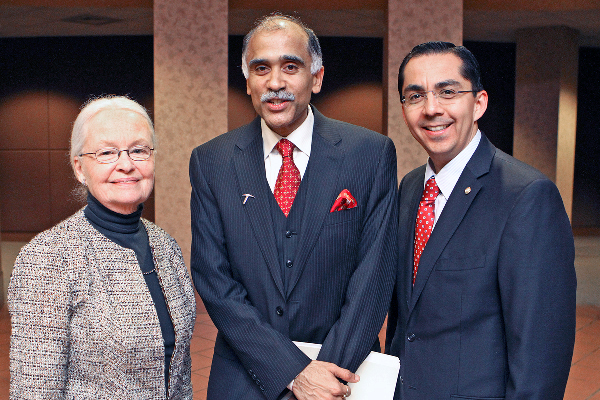Originally published March 6, 2015
By Daniel Perez
UTEP News Service
A representative from the Republic of India shared data about his country’s transformation into one of the world’s more potent economies during a recent Centennial Lecture at The University of Texas at El Paso, but his overarching message was simple: India is ready for business.

The Honorable Parvathaneni Harish, consul general of India in Houston, Texas, powered through an extensive presentation about his country’s economic reforms and its efforts to encourage foreign investors, foster academic and research collaborations, and create opportunities for its young and growing workforce.
Harish shared “The Indian Economy: Opportunities for Business and Industry” with an attentive audience March 2 in UTEP’s Undergraduate Learning Center. He explained the deliberate steps his government has taken since 1991 to steer the world’s largest democracy and second-largest populated nation into becoming an emerging economy. He likened the slow process to changing directions on an ocean liner.
He quoted his country’s prime minister, Narendra Modi, who has worked to simplify regulations to foreign investment in the areas of energy, infrastructure, manufacturing, and skill and business development.
“No more red tape, only red carpet,” quipped Harish, a trained mechanical engineer who joined India’s Foreign Service in 1990.
Today, the country has a gross domestic product of $2 trillion, a vibrant stock market, a controlled inflation rate and an economic growth rate of 7.4 percent. Its strong and stable government leads a population of 1.2 billion – almost half of which is under age 25. The goal is to help many of them shift from farm jobs to manufacturing or the service industry.
The republic has a world-class information technology service industry and a growing number who take advantage of it. Approximately 900 million Indians own cell phones, including 300 million phones with Internet access. Technology has allowed for banking in rural areas and provided farmers and fishermen with up-to-the-minute weather forecasts or market information, which improves their efficiency and productivity.
“If there is one factor that has dramatically influenced our economy, it is the cell phone,” Harish said. “It significantly impacts the way we do business.”
Robert Nachtmann, D.B.A., dean of the College of Business Administration, said he has witnessed the growth of the Indian economy during visits to the country over the past 30 years. He said the country’s leaders have done a phenomenal job with the economy for the past decade.
“There’s optimism, but also concerns about the reforms,” Nachtmann said. “Will they be churned as political structures change? If they don’t, the country has no reason not to take off.”
After his presentation, Harish took a few minutes to share his observations of the campus, the feedback he gets from UTEP’s Indian students and alumni, and future opportunities for collaboration.
He called UTEP an “unexpected gem” because of its unique and consistent use of Bhutanese architecture and multinational student body that is nurtured to succeed. Indian students make up the second-largest contingent of foreign students at the University after Mexico. Since the mid-1990s, hundredsof Indian students have enrolled at UTEP. Harish said those who have attended the University praise the education they received at UTEP, which he lauded for its first-rate faculty and dedicated student body.
“The University has an excellent track record,” said Harish, whose consulate serves a region made up of Kansas, Texas, Arkansas, Nebraska, Colorado, New Mexico, Oklahoma and Louisiana. “I was very deeply impressed.”
He said he would like to see UTEP and other U.S. academic institutions in his region find ways to collaborate with universities in India in research, summer internships, and student and faculty research exchanges. One previous partnership involved a student/teacher exchange program with the Indian Institute of Technology in Kharagpur in 2008-10 to study highway and airport pavement engineering.
University President Diana Natalicio, who introduced the speaker, said she was grateful to hear the consul general’s perspectives and that the University would try to identify future opportunities to collaborate with Indian universities.
“Opportunities like this give us a chance to enhance our understanding of the world around us,” she said during a reception for Harish that followed his presentation. “Increasingly, that is critical to a prosperous future.”
Neelam Agarwal, assistant director of UTEP’s Center for Accommodations and Support Services, said she was interested in learning about her native country’s economic emergence and its planned path to sustain its growth. She said the University community would benefit from similar presentations by representatives from other countries.
“These talks help you to see things from another point of view,” said Agarwal, who came to the United States from India in 2001 to pursue her graduate degree in developmental psychology. “It was a good time to have this conversation to create more interest and hear how we can help and learn from each other.”
The Federal Reserve Bank of Dallas, El Paso Branch, co-sponsored the event.